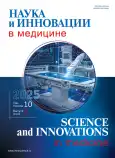Kinematic analysis of gait in children with rigid flatfoot before and after surgical treatment
- Authors: Khodjanov I.Y.1, Umarov X.I.2, Khakimov S.K.3, Mirzaev A.G.1
-
Affiliations:
- Republican specialized scientific and practical medical center traumatology and orthopaedics
- Andijan State Medical Institute
- Bukhara State Medical Institute named after Abu Ali ibn Sino
- Issue: Vol 10, No 2 (2025)
- Pages: 155-160
- Section: Traumatology and Orthopedics
- URL: https://journal-vniispk.ru/2500-1388/article/view/316068
- DOI: https://doi.org/10.35693/SIM655654
- ID: 316068
Cite item
Abstract
Aim – to study the kinematics and kinetics of walking in children with rigid flatfoot by comparing data before and after surgical operations.
Material and methods. The study included 51 patients (42 boys, 9 girls) with rigid flatfoot, with a mean age of 10.5 ± 1.4 years. They were stratified by disease stage and underwent surgical treatment using the author’s technique: ‘transposition of the m. peroneus longus tendon medially, shortening of the m. tibialis posterior tendon, and arthrodesis of the cuneo-navicular joint’.
Results. It was found that higher disease stages correlated with increased step time and support time, and decreased swing time, average walking speed, and step frequency (<0.01 to <0.001). Disease progression also exacerbated pathomorphological changes in the foot, driven by biomechanical dysfunction of the lower leg’s pronator and supinator muscles, alongside reduced gait energy efficiency.
Conclusion. Gait kinematic assessment, when combined with standard diagnostic tools for rigid flatfoot (e.g., radiography and podometry), enhances the identification of effective and precise treatment strategies. The proposed disease stage-adjusted corrective approach addresses all components of rigid flatfoot: it eliminates pathological pronation, restores supination and plantar flexion function, and achieves adequate foot arch reconstruction.
Keywords
Full Text
##article.viewOnOriginalSite##About the authors
Iskandar Yu. Khodjanov
Republican specialized scientific and practical medical center traumatology and orthopaedics
Email: prof.khodjanov@mail.ru
ORCID iD: 0000-0003-3964-4148
MD, Dr. Sci. (Medicine), Head of orthopedic department No. 2
Uzbekistan, ТashkentXasanali I. Umarov
Andijan State Medical Institute
Author for correspondence.
Email: umarovhasanboj47@gmail.com
ORCID iD: 0009-0008-5466-1687
MD, traumatologist-orthopedist
Uzbekistan, AndijanSherali K. Khakimov
Bukhara State Medical Institute named after Abu Ali ibn Sino
Email: kuzievich_81@mail.ru
ORCID iD: 0000-0003-3779-6025
Cand. Sci. (Medicine), Associate Professor
Uzbekistan, BukharaAnvar G. Mirzaev
Republican specialized scientific and practical medical center traumatology and orthopaedics
Email: m.anvardoc@gmail.com
ORCID iD: 0000-0001-9796-2959
Cand. Sci. (Medicine), Head of the Gait Laboratory
Uzbekistan, ТashkentReferences
- Pourghazi F, Nabian MH, Bakht SS, et al. Changes in gait pattern and quality of life of adolescents with flexible flat foot after Calcaneal Lengthening Osteotomy. Foot. 2023;57:101962. doi: 10.1016/j.foot.2023.101962
- Boryczka-Trefler A, Kalinowska M, Szczerbik E, et al. Effect of Plano-Valgus Foot on Lower-Extremity Kinematics and Spatiotemporal Gait Parameters in Children of Age 5–9. Diagnostics. 2022;12(1):2. doi: 10.3390/diagnostics12010002
- Stief F, Böhm H, Michel K, et al. Reliability and accuracy in three-dimensional gait analysis: a comparison of two lower body protocols. J Appl Biomech. 2013;29:105-111. doi: 10.1123/jab.29.1.105
- Levinger P, Murley GS, Barton CJ, et al. A comparison of foot kinematics in people with normal- and flat-arched feet using the Oxford Foot Model. Gait Posture. 2010;32(4):519-523. doi: 10.1016/j.gaitpost.2010.07.013
- Kim HY, Cha YH, Lee JS, et al. Changes in gait and radiographic and clinical results of calcaneal lengthening osteotomy in children with idiopathic flexible flatfoot. Clin Orthop Surg. 2020;12:386-395. doi: 10.4055/cios19150
- Krautwurst BK, Wolf SI, Dreher T. Three-dimensional evaluation of heel raise test in pediatric planovalgus feet and normal feet. Gait Posture. 2016;48:146-151. doi: 10.1016/j.gaitpost.2016.05.003
- Mosca VS. Flexible flatfoot in children and adolescents. J Child Orthop. 2010;4(2):107-21. doi: 10.1007/s11832-010-0239-9
- Kim HY, Shin HS, Ko JH, et al. Gait Analysis of Symptomatic Flatfoot in Children: An Observational Study. CiOS. Clin Orthop Surg. 2017;9:363-373. doi: 10.4055/cios.2017.9.3.363
- Caravaggi P, Sforza C, Leardini A, et al. Effect of plano-valgus foot posture on midfoot kinematics during barefoot walking in an adolescent population. J Foot Ankle Res. 2018;11:55. doi: 10.1186/s13047-018-0297-7
- Portinaro N, Leardini A, Panou A, et al. Modifying the Rizzoli foot model to improve the diagnosis of pes-planus: Application to kinematics of feet in teenagers. J Foot Ankle Res. 2014;7:57. doi: 10.1186/s13047-014-0057-2
- Wenger DR, Mauldin D, Speck G, et al. Corrective shoes and inserts as treatment for flexible flatfoot in infants and children. J Bone Joint Surg Am. 1989;71(6):800-10. PMID: 2663868
- Das SP, Das PB, Ganesh S, et al. Effectiveness of surgically treated symptomatic plano-valgus deformity by the calcaneo stop procedure according to radiological, functional and gait parameters. J Taibah Univ Med Sci. 2017;12;102-109. doi: 10.1016/j.jtumed.2016.11.009
- Twomey D, McIntosh A. The effects of low arched feet on lower limb gait kinematics in children. Foot. 2012;22:60-65. doi: 10.1016/j.foot.2011.11.005
- Twomey D, McIntosh A, Simon J, et al. Kinematic differences between normal and low arched feet in children using the Heidelberg foot measurement method. Gait Posture. 2010;32:1-5. doi: 10.1016/j.gaitpost.2010.01.021
- Papamerkouriou Y-M, Rajan R, Chaudhry S, et al. Prospective early clinical, radiological, and kinematic pedobarographic analysis following subtalar arthroereises for paediatric pes planovalgus. Cureus. 2019;11:e6309. doi: 10.7759/cureus.6309
- Böhm H, Stebbins J, Kothari A, Dussa CU. Dynamic gait analysis in paediatric flatfeet: unveiling biomechanical insights for diagnosis and treatment. Children. 2024;11(5):604. doi: 10.3390/children11050604
- Ghazaleh L, Hoseini Y, Masoomi F, et al. Ground reaction force analysis in flexible and rigid flatfoot subjects. J Bodyw Mov Ther. 2024;39:441-446. doi: 10.1016/j.jbmt.2024.02.020
- Bauer K, Mosca VS, Zionts LE. What’s New in Pediatric Flatfoot? J Pediatr Orthop. 2016;36:865-869. doi: 10.1097/BPO.0000000000000582
- MacInnes P, Lewis TL, et al. Surgical management of pes planus in children with cerebral palsy: A systematic review. J Child Orthop. 2022;16:333-346. doi: 10.1177/18632521221112496
- Cen X, Yu P, Song Y, et al. Influence of medial longitudinal arch flexibility on lower limb joint coupling coordination and gait impulse. Gait Posture. 2024;114:208-214. doi: 10.1016/j.gaitpost.2024.10.002
- Ha Yong Kim, Hyuck Soo Shin, Jun Hyuck Ko, et al. Gait analysis of symptomatic flatfoot in children: anobservational study. Clin Orthop Surg. 2017;9(3):363-373. doi: 10.4055/cios.2017.9.3.363
- Saraswat P, Macwilliams Ba, Davis Rb, D’astous Jl. Kinematics and kinetics of normal and planovalgus feet during walking. Gait Posture. 2014;39(1):339-45. doi: 10.1016/j.gaitpost.2013.08.003
Supplementary files







